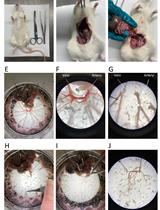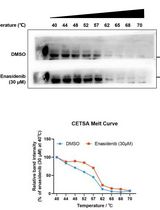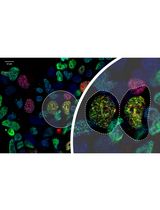- EN - English
- CN - 中文
Single-molecule Force Spectroscopy on Biomembrane Force Probe to Characterize Force-dependent Bond Lifetimes of Receptor–ligand Interactions on Living Cells
生物膜力探针的单分子力谱表征活细胞上受体-配体相互作用的力依赖性键的寿命
发布: 2022年10月20日第12卷第20期 DOI: 10.21769/BioProtoc.4534 浏览次数: 2372
评审: Willy R Carrasquel-UrsulaezChen FanAnonymous reviewer(s)

相关实验方案

利用近端连接分析在新鲜分离的大鼠血管平滑肌细胞中定量Kv7.4与Dynein蛋白的相互作用
Jennifer van der Horst and Thomas A. Jepps
2024年03月20日 1500 阅读
Abstract
The transmembrane receptor–ligand interactions play a vital role in the physiological and pathological processes of living cells, such as immune cell activation, neural synapse formation, or viral invasion into host cells. Mounting evidence suggests that these processes involve mechanosensing and mechanotransduction, which are directly mediated by the force-dependent transmembrane receptor–ligand interactions. Some single-molecule force spectroscopy techniques have been applied to investigate force-dependent kinetics of receptor–ligand interactions. Among these, the biomembrane force probe (BFP), a unique and powerful technique, can quantitatively and accurately determine the force-dependent parameters of transmembrane receptor–ligand interactions at the single-molecule level on living cells. The stiffness, spatial resolution, force, and bond lifetime range of BFP are 0.1–3 pN/nm, 2–3 nm, 1–103 pN, and 5 × 10-4–200 s, respectively. Therefore, this technique is very suitable for studying transient and weak interactions between transmembrane receptors and their ligands. Here, we share in detail the in situ characterization of the single-molecule force-dependent bond lifetime of transmembrane receptor–ligand interactions, based on a force-clamp assay with BFP.
Keywords: Biomembrane force probe (生物膜力探针)Background
Traditional biochemical methods, such as co-immunoprecipitation, surface plasmon resonance, bio-layer interferometry, or isothermal titration calorimetry, are widely employed to determine the kinetics of receptor–ligand interactions (Cole et al., 2007; Hui et al., 2017; Marasco et al., 2020; Maruhashi et al., 2022). These binding kinetics—on-rate kon, off-rate koff, and equilibrium dissociation constant KD—are detected at a static equilibrium state in solution. Remarkably, however, transmembrane receptors are restricted to the plasma membrane of the cells. Their anchor pattern, orientation, and diffusion rate on the plasma membrane can directly tune the accessibility and association possibility to affect in situ kinetics of receptor–ligand interactions (Dustin et al., 2001; Huang et al., 2004; Hu et al., 2019; Zhang et al., 2021). Therefore, the determination of in situ receptor–ligand binding kinetics on living cells is urgent for understanding the biological functions induced by transmembrane receptor–ligand interactions.
Transmembrane receptors and their ligands also experience mechanical forces on the plasma membrane, which mainly derive from living cell’s movement, cell–cell contact, and dynamic changes to the plasma membrane or cytoplasmic cytoskeleton (Zhu et al., 2019). Many studies have shown that mechanical forces can act on transmembrane receptors and ligands to dynamically regulate their binding kinetics by altering their conformations. For example, SARS-CoV-2 viral invasion induces host cell membrane bending, which generates the tensile force to prolong the bond lifetime of spike/ACE2 interaction, fostering viral entry (Hu et al., 2021). Also, mechanical forces directly enhance the interaction of T-cell receptors (TCR) and agonist peptide-loaded major histocompatibility complex, which can accurately determine TCR antigen recognition (Liu et al., 2014; Wu et al., 2019). From the molecular mechanism, the mechanical force could allosterically regulate the conformation of the transmembrane receptors and ligands, generate force-induced intermediate binding states, and govern dissociation pathway selection to impede their dissociation (Sarangapani et al., 2004; Hong et al., 2015; Wu et al., 2019; Zhu et al., 2019). Also, a sliding-rebinding mechanism is applied to explain force-enhanced transmembrane receptor–ligand binding strength (Lou and Zhu, 2007).
Single-molecule force spectroscopy techniques—such as atomic force microscopy, optical tweezers, magnetic tweezers, or biomembrane force probe (BFP)—have become important for studying the force-dependent kinetics of receptor–ligand interactions (Marshall et al., 2003; Kim et al., 2010; Chen and Zhu, 2013; Kong et al., 2013). Among these, BFP can quantitatively and accurately determine the force-dependent bond lifetime of transmembrane receptor–ligand interactions at the single-molecule level on living cells. The BFP technique uses soft human red blood cells (RBC, which have a proper elasticity for pN-level force detection) attached to microbeads as force sensors (Figure 1). When the transmembrane receptor expressed on the target cell binds to recombinant ligand–coated microbeads, the magnitude of the mechanical force is calculated according to the deformation of RBC, and the bond lifetime is recorded by a high-speed camera. The stiffness, spatial resolution, force, and bond lifetime range of BFP are 0.1–3 pN/nm, 2–3 nm, 1–103 pN, and 5 × 10-4–200 s, respectively (Evans et al., 1995; Chen et al., 2008; An et al., 2020). Therefore, BFP has the advantages of ultra-high mechanical detection accuracy of optical tweezers and magnetic tweezers, and also the high dynamic response characteristics of atomic force microscopy, being very suitable for studying transient and weak interactions between transmembrane receptors and their ligands in situ.

Figure 1. Schematic diagram of BFP setup. The left micropipette holds the force probe, which contains a soft RBC attached to a ligand-coated bead. The right micropipette aspirates a transmembrane receptor-expressing target cell.
Materials and Reagents
6-well plate (JetBioFil, catalog number: TCP011006)
0.45 μm filter (JetBioFil, catalog number: FPV403013)
Micropipette tips [Crystalgen, catalog numbers: 23-5104 (10 μL); 23-3346 (200 μL); 23-3150 (1,000 μL)]
1.5 mL tubes (Crystalgen, catalog number: 23-2052)
1.5 mL low surface tension tubes (Simport, catalog number: T330-7LST)
15 mL tube (Crystalgen, catalog number: 232266)
50 mL tube (Crystalgen, catalog number: 203102)
0.5 μm capillary glass tube (West China Medical University Instrument Factory, catalog number: 10032512166199)
22 × 40 mm microscope cover glass (Fisherbrand, catalog number: 12-545C)
Micro injector (World Precision Instruments, catalog number: MF28G67-5)
Glass vials (Hamag Technology Co., Ltd., catalog number: HM-4455A)
10 cm dish (JetBioFil, catalog number: MCD110090)
Twist lancet (HURHONG, catalog number: IR28100200)
3-mercapto-propyl-trimethoxysilane (MPTMS) (United Chemical Technologies, Inc., catalog number: M8500)
Biotin-PEG 3500-SGA (JenKem, catalog number: 62717)
Streptavidin-maleimide (SA-MAL) (Sigma, catalog number: S9415)
30% bovine serum albumin (BSA) (Sigma, catalog number: A0336)
Nystatin (Sigma, catalog number: N4014)
Borosilicate glass beads (Duke Scientific, catalog number: 9002)
Streptavidin (Sangon Biotech, catalog number: A1004970-0001)
PBS (Genom, catalog number: GNM20012-2)
Mineral oil (Fisher Scientific, catalog number: BP2629-1)
pMD2.G plasmid (Addgene, catalog number: 12259)
psPAX2 plasmid (Addgene, catalog number: 12260)
Polyethylenimine linear (PEI) (Yeasen, catalog number: 40816ES02)
Trypsin (Yeasen, catalog number: 40127ES60)
RPMI 1640 medium (BasalMedia, catalog number: L220KJ)
DMEM medium (BasalMedia, catalog number: L110KJ)
293T (From Sun Qiming’s Laboratory)
FBS (Yeasen, catalog number: 40130ES76)
Lentiviral plasmid (From Sun Qiming’s Laboratory)
Argon (Shanghai Wugang Gas Co., Ltd)
Phosphate buffer (see Recipes)
C buffer (see Recipes)
N2 buffer (see Recipes)
CR buffer (see Recipes)
Cleaning buffer I (see Recipes)
SA-MAL stock solution (see Recipes)
PEI solution (see Recipes)
Nystatin stock solution (see Recipes)
Equipment
50 mL beaker
Micropipettes 20, 200, 1000 (Eppendorf)
Centrifuge (Eppendorf, catalog number: 5424R)
4 °C refrigerator (Melng, catalog number: YC-300L)
Z2 cell counter (Beckman, catalog number: AY52487)
Micropipette holder (Narishige, catalog number: HI-7)
Micro forge (Narishige, catalog number: MF-900)
Rotator (Qilinbeier, catalog number: BE-1100)
Micropipette puller (Sutter Instrument, catalog number: P-1000)
Biomembrane force probe (BFP, built by our laboratory)
Desiccator (Yue Cheng Trading, catalog number: PC-150mm PC-150)
Lancing device (HURHONG, catalog number: 116B015002)
Vacuum pump (JINTENG, catalog number: GM-0.33A)
Cell incubator (Heal Force, catalog number: HF90)
Flow cytometer (Beckman, catalog number: CytoFLEX S)
Cover glass (Fisherbrand, catalog number: 12545C)
Light source microscope (Nikon, catalog number: Eclipse Ti)
Electric-thermostatic water bath (Shang Hai Jing Hong, catalog number: XMTD 8222)
Software
LabVIEW 14.0 Development System
Prism 8
Microsoft Excel 2019
BFP program (written by our laboratory)
Procedure
文章信息
版权信息
© 2022 The Authors; exclusive licensee Bio-protocol LLC.
如何引用
Readers should cite both the Bio-protocol article and the original research article where this protocol was used:
- Zhang, T., An, C., Hu, W. and Chen, W. (2022). Single-molecule Force Spectroscopy on Biomembrane Force Probe to Characterize Force-dependent Bond Lifetimes of Receptor–ligand Interactions on Living Cells . Bio-protocol 12(20): e4534. DOI: 10.21769/BioProtoc.4534.
- Hu, W., Zhang, Y., Fei, P., Zhang, T., Yao, D., Gao, Y., Liu, J., Chen, H., Lu, Q., Mudianto, T., et al. (2021). Mechanical activation of spike fosters SARS-CoV-2 viral infection. Cell Res 31(10): 1047-1060.
分类
生物物理学 >
分子生物学 > 蛋白质 > 蛋白质-蛋白质相互作用
您对这篇实验方法有问题吗?
在此处发布您的问题,我们将邀请本文作者来回答。同时,我们会将您的问题发布到Bio-protocol Exchange,以便寻求社区成员的帮助。
Share
Bluesky
X
Copy link











